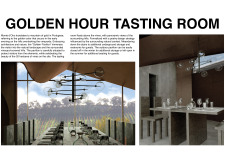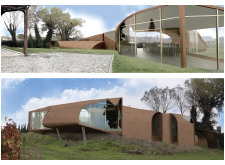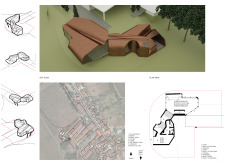5 key facts about this project
Integration with Natural Environment
One of the key aspects of the project is its design philosophy, which aims to create a harmonious relationship between architecture and the surrounding landscape. The curvilinear form of the pavilion is inspired by the undulating topography of the vineyard. This approach not only facilitates impressive views but also minimizes the building's visual impact on the surroundings. The design features cantilevered sections and slanted roofs, which help to create dynamic spatial experiences and allow for optimal daylighting throughout the day.
The use of materials in the Golden Hour Tasting Room is another defining characteristic that distinguishes it from other tasting venues. Corten steel cladding provides a weathered aesthetic that blends with the earthy tones of the vineyard, while raw concrete inside offers a contemporary and minimalistic contrast. Extensive glazing gives a frameless view of the landscape, reinforcing the connection to nature. Additionally, wood accents may be utilized within the interior to introduce warmth, contributing to the overall sensory experience.
Functional Versatility and User Experience
The Golden Hour Tasting Room is designed with flexibility in mind, allowing it to accommodate various functions throughout the year. This adaptability enables the pavilion to transition from an open and airy space during warmer months to a more enclosed environment suitable for winter. The arrangement of seating, including a communal tasting table, fosters interaction among visitors, enhancing the social aspect of wine tasting.
The project also includes innovative storage solutions, with underground spaces that maintain the cleanliness of the design while providing essential functionality. The architectural detailing incorporates thematic elements that resonate with the vineyard context, such as lighting fixtures reminiscent of vines and grapes, further enhancing the thematic coherence of the space.
This project exemplifies a comprehensive approach to vineyard architecture, focusing on user experience, environmental integration, and materiality. To discover more about the architectural plans, sections, and overall design intent, readers are encouraged to explore further details of the Golden Hour Tasting Room project.


























